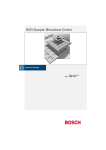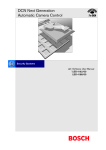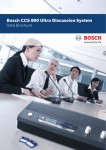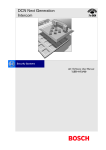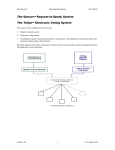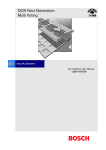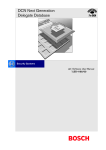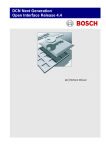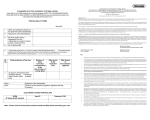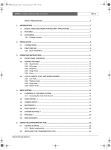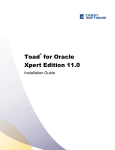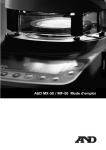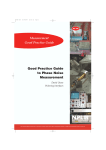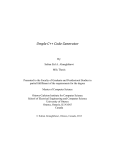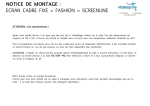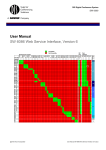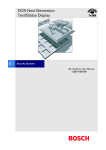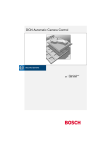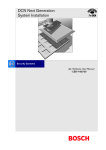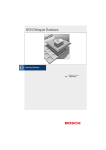Download DCN Next Generation Synoptic Microphone Control
Transcript
DCN Next Generation Synoptic Microphone Control en Software User Manual LBB 4171/00 About this manual This user manual is divided into five chapters. Chapters 1 and 2 provide background information; chapter 3 and 4 provides detailed user information as follows: • • • • Manual conventions For clarity this user manual uses consistent styles, symbols and typographical conventions. They are: i Chapter 1 - Synoptic Microphone Control containing a brief overview of the Digital Congress Network Next Generation, a summary of the application modules available and an overview of the functionality of the Synoptic Microphone application. Chapter 2 - Getting Started - containing details on how to start the Synoptic Microphone Control application from the Startup screen and a description of the Help facility. Chapter 3 - Preparing for a Conference containing details about the layout mode, instructions about making a synoptic layout for the first time and editing existing synoptic layouts, and exiting layout mode. Chapter 4 - Controlling a Conference containing details about the control mode, instructions about assigning operational modes and accessing conference information, controlling a conference and exiting control mode. Note General notes are contained within rules and indicated with this symbol at the left margin. Notes are used to draw attention to special actions or information. i Caution A caution is contained within rules and indicated with this symbol at the left margin. Cautions are used to draw attention to actions or commands that could lead to a loss of information or damage to equipment i Tip A tip is contained within a box and indicated with this symbol at the left margin. Tips are used to provide supplementary information that may make an action quicker or easier to carry out. • An action (to be carried out by the user) is shown with a larger round bullet mark. Typographical conventions The following typographical conventions (text styles) are used in this manual: • Typed input - information to be typed in using the keyboard is shown as: Filename • Single key - input via a single key (or keys) on the keyboard is shown as: <enter>, <shift>, etc. • Multiple keys - input via a combination of keys pressed together is shown as: <ctrl>+<p>, <alt>+<f4> • Screen text - information that appears on screen is shown as: ‘Choose Startup Modules:’ Hyperlinks This manual is also available as a digital document in the Adobe Portable Document Format (PDF). All references to pages, figures, tables, etc. in this digital document contain hyperlinks to the referenced location. DCN Next Generation Synoptic Microphone Control en | 3 Table of contents 1 Synoptic Microphone Control ............................. 4 1.1 About Synoptic Microphone Control................. 4 1.1.1 What is Synoptic Microphone Control? ........... 4 Layout mode ............................................................ 4 Control mode........................................................... 4 1.2 What is a synoptic layout?................................... 4 1.2.1 Making a graphical representation ..................... 4 1.3 Controlling microphones ...................................... 4 1.3.1 Conference procedures........................................ 4 1.3.2 Microphone operation modes ............................. 4 Microphone control by operator with request list ............................................................................... 5 Microphone control by operator with request and response list .................................................... 5 Microphone control by delegate with request list ............................................................................... 5 Microphone control by delegate with override 5 Microphone control by delegate with voice activation................................................................... 5 2 Getting started............................................................ 6 2.1 Starting Synoptic Microphone Control ............. 6 2.1.1 The Startup screen ................................................ 6 Selecting an installation- (and a names) file..... 6 The Synoptic Microphone Control icon ............ 6 2.2 Using Help ............................................................... 6 2.2.1 The Help menu........................................................ 6 2.2.2 Index .......................................................................... 6 2.2.3 Keyboard .................................................................. 7 2.2.4 Commands............................................................... 7 2.2.5 Procedures............................................................... 7 2.2.6 Glossary.................................................................... 7 2.2.7 Using Help ............................................................... 7 2.2.8 About ......................................................................... 7 3 Preparing for a conference .................................. 8 3.1 Using layout mode.................................................. 8 3.1.1 The main window.................................................... 8 3.1.2 The menu bar........................................................... 8 3.1.3 The tool box ............................................................. 8 3.2 Making a layout ....................................................... 9 3.2.1 Layout Options........................................................ 9 3.2.2 Microphone seat numbers.................................... 9 Displaying seat numbers....................................... 9 Automatic seat numbering ................................... 9 Small or large icons ............................................... 9 Displaying a red background for active microphones ............................................................ 9 Displaying a layout grid ......................................... 9 Snapping to the grid............................................10 Rotating icons .......................................................10 3.2.3 Positioning icons on a layout .............................10 3.2.4 Editing icons in a layout ......................................10 Deleting icons........................................................10 Cutting and pasting icons ..................................11 Copying and pasting icons ................................11 3.3 3.3.1 3.3.2 3.4 3.4.1 3.5 4 4.1 4.1.1 4.1.2 4.1.3 4.2 4.3 4.3.1 4.4 4.4.1 4.5 4.6 4.7 4.7.1 4.7.2 Bosch Security Systems B.V. | 2005 January | 9922 141 70351 Editing seat numbers .......................................... 11 Altering the default screen line length............. 11 Specifying conference procedures.................. 12 Specifying the microphone operation mode.. 12 Microphone Control By ...................................... 12 Microphone Setting ............................................. 12 Active Mics ............................................................ 12 Specifying additional microphone parameters12 Microphone Activity ............................................. 12 Attention Tone....................................................... 14 Ambient Microphone ........................................... 14 Microphones Off After Shift .............................. 14 Working with layout files .................................... 14 Layout file options ................................................ 14 Creating a new layout file................................... 14 Opening an existing layout file .......................... 15 Saving a layout file ............................................... 16 Saving a layout file under a new name............ 16 Deleting a layout file ............................................ 16 Importing a bitmap ............................................... 16 Going to control mode........................................ 17 Controlling a conference .................................... 18 What is control mode? ....................................... 18 Monitoring and controlling a conference........ 18 Conventions used in this chapter..................... 18 Icon status ............................................................. 18 Control mode display options ........................... 18 Small or large icons ............................................. 18 Displaying seat numbers .................................... 19 Rotate...................................................................... 19 Displaying a red background for active microphones.......................................................... 19 Using control mode ............................................. 19 Switching microphones on and off .................. 19 Switching microphones on ................................ 19 Switching microphones off ................................ 19 Clearing all requests-to-speak .......................... 20 Action box .............................................................. 20 Accessing conference information .................. 20 Checking the conference status ...................... 20 Returning to layout mode ................................... 20 Printing.................................................................... 21 Microphone testing.............................................. 21 Exiting synoptic microphone control................ 22 Temporarily exiting Synoptic Microphone Control.................................................................... 22 Permanently exiting Synoptic Microphone Control.................................................................... 22 DCN Next Generation Synoptic Microphone Control 1 Synoptic Microphone Control en | 4 returning to layout mode. i Before creating a layout, it is useful to know the seat numbers assigned to all microphones connected to the system. This helps assigning seat numbers to icons in your layout, as Synoptic Microphone Control does not give a list of all available seat numbers. Seat numbers are assigned using the System Installation software (LBB 4185) and are stored in an installation file. 1.1 About Synoptic Microphone Control 1.1.1 What is Synoptic Microphone Control? The Synoptic Microphone Control software program is one of a family of modules designed for controlling and monitoring conferences and discussions using the contribution equipment. It is used for configuring and controlling microphones connected to the system, and uses icons to produce a graphical representation of a conference-seating plan. The result is a highly visual ‘push-button’ conference control program. Synoptic Microphone Control has two modes: • Layout mode • Control mode Layout mode Is used to create a synoptic view, which contains an arrangement of icons corresponding to the positions of actual microphones in the conference venue. Each type of contribution equipment (delegate unit, chairman unit, etc.) has its own icon. Synoptic layouts can be created and modified in layout mode. Refer to chapter 3. Control mode Is used to monitor and control a conference. In control mode, the color of a particular icon depends on the state (request-to-speak, active, etc.) of the actual microphone it represents. Synoptic layouts generated in layout mode are used in control mode. Refer to chapter 4. 1.2 What is a synoptic layout? 1.2.1 Making a graphical representation A synoptic layout is a graphical representation of the actual location of the microphones, delegate units and chairman units in a room or hall. What you create on screen is a plan view of how your conference venue looks. The layout mode of Synoptic Microphone Control contains tools for creating and editing such layouts. Icons (graphical representations) of the contribution equipment are used to build up the layout. In control mode, the icons you have positioned in the layout become functional, and a conference can be monitored and/or controlled. The icons are used as status indicators or buttons to initiate actions for the unit the icon represents. Icons cannot be moved in control mode, but a layout can always be edited by Tip 1.3 Controlling microphones 1.3.1 Conference procedures To successfully set-up, conduct and organize a conference it is necessary to provide microphone management procedures, which facilitate many different types of conference or discussion. The system operator (or conference chairman) requires a choice of operating modes for controlling delegates waiting to speak, and the number of delegates who can speak at the same time. In addition, an automatic mode of operation, that does not need operator (or chairman) involvement, is essential. 1.3.2 Microphone operation modes Allowing conference delegates to activate their microphones whenever they desire would almost certainly lead to confusion. However, in some smaller discussion groups, it is acceptable to allow a certain amount of freedom. Microphone operation modes must allow for all circumstances. i Note In this manual, reference is made to the request list, response list and speakers list. However, it is not possible to view these lists on-screen using Synoptic Microphone Control. For more details, refer to the Microphone Management user manual. To manage and control the way delegates and/or the system operator activate microphones, five microphone operation modes are possible: • Microphone control by operator with request list • Microphone control by operator with request and response list • Microphone control by delegate with request list • Microphone control by delegate with override Bosch Security Systems B.V. | 2005 January | 9922 141 70351 DCN Next Generation Synoptic Microphone Control • Microphone control by delegate with voice activation i Note All modes are selected using the ‘System Mic. Mode...’ command in the ‘Settings’ menu. For more information refer to paragraph 3.3.1. Microphone control by operator with request list Useful in formal, highly structured meetings in which participants join a ‘request-to-speak’ list by activating a key on their delegate unit. They can only be promoted to active status (speaker) via the operator. The operator can see which delegate is first in the request-to-speak list. An operator ‘shift’ function gives this delegate active status and switches off the microphone of the delegate who has been speaking longest. The maximum number of simultaneous active microphones (speakers) can be pre-set by the operator. When a participant presses the microphone on/off key on the delegate unit, it is indicated as a ‘requestto-speak’. No further action is required, and when the delegate receives active status, the microphone is automatically switched on (indicated by an illuminated red LED). i Note When a delegate is listed in the request list the green LED at the unit is lit, simultaneously the green microphone LED is lit. When the delegate is the first in the request list both LEDs will flash to indicate that the microphone will be switched on soon. Microphone control by operator with request and response list Also intended for formal, highly structured meetings, and is similar to microphone control by operator with request list. However, as well as joining a ‘request-to-speak’ list, it is now possible for a delegates to make a response request using the middle votting button on his/her delegate conference unit. This is useful in situations where a delegate wants to give a prompt answer to a matter raised by the speaker. This request will be given temporary priority, and will appear at the top of the request list. When such a response request is promoted to active status, the current speaker is deactivated, but remains on the speakers list, and the response delegate is promoted to the ‘response’ list. The maximum number of response requests is five, only one of which can be active at any time. en | 5 Microphone control by delegate with request list Useful in less formal meetings where the order of speaking is determined by the participants and not the operator. When delegates switch their microphones on, they are automatically promoted to the speakers list, providing the speakers list is not full. No operator action is required to control the conference, though it is possible. The operator can also pre-specify the number of speakers. When the speakers list is full and delegates not on the speakers list press their microphone button, they are placed on the request-to-speak list. This list is in chronological order, and the participant at the top of the list is automatically promoted to active status when a currently active speaker switches his/her microphone off. All other participants move up one place. When the operator switches off an active microphone, the delegate at the top of the request-tospeak list is automatically promoted to the speakers list. Microphone control by delegate with override Useful for smaller discussions where participants are given active status by activating a contribution unit key. The microphone of the speaker who has been speaking the longest is automatically switched off. No operator action is required. There is no request-tospeak list (this mode is sometimes called ‘first-in-firstout’ or FIFO mode). The maximum number of active microphones (speakers) can be preset by the operator. When a participant presses the microphone on/off key on the delegate unit, it is automatically switched on and the delegate receives active status (indicated by an illuminated red LED). Microphone control by delegate with voice activation Useful in active discussions in which participants activate their microphones by speaking (on/off button is not required). They are automatically given active status (speaker) while speaking. No operator action is required. There is no request-to-speak list, response list or speakers list. The number of simultaneous active status microphones (speakers) can be preset by the operator. i Bosch Security Systems B.V. | 2005 January | 9922 141 70351 Note Operator control and microphone status monitoring are not possible in ‘Voice Activation’ mode. DCN Next Generation Synoptic Microphone Control 2 Getting started en | 6 installation or names file. Synoptic Microphone Control requires both an installation file and a names file for full functionality, but will work with only an installation file. 2.1 Starting Synoptic Microphone Control i 2.1.1 The Startup screen The Synoptic Microphone Control program is started from the Startup screen (shown below). Note A names file is needed to show screenline icons. Selecting an installation- (and a names) file For details on selecting an installation- (and a names) file, please refer to paragraph 3.2.1 ‘Selecting an installation- and a names file’ of the Startup user manual. The Synoptic Microphone Control icon For details on the Synoptic Microphone Control icon and how to start Synoptic Microphone Control from Startup, please refer to paragraph 3.2.2 Opening other modules from Startup’ of the Startup user manual. 2.2 Using Help Figure 1 The Startup screen i Note For starting the Startup program from an icon in the Windows desktop, refer to the Startup user manual. The software uses two user-created files that contain important information about the installed hardware configuration and about delegates’ names. These files are: • Installation file - containing information about channel assignment and the numbers that have been assigned to all microphones connected to the . These seat numbers are assigned using the System Installation software (LBB 4185). • Names file - containing information about the name, seat number and other conference and personal details of participating delegates. Names files are created using the Delegate Database software (LBB 4180). The software modules may be started up from the Startup main window without specifying either an installation or names file. However, some software modules will not run without the appropriate 2.2.1 The Help menu The ‘Help’ menu in the title bar contains commands for an on-screen help facility. This help facility contains information on all commands in the ‘File’ menu, on which keyboard keys are functional, a description of how to use the software, information on how to use the help facility itself, plus an index and a glossary of terms. All information contained in this user manual is also found in the ‘Help’ facility. The ‘Help’ facility contains the following options: • Index • Keyboard • Commands • Procedures • Glossary • Using Help • About Synoptic Microphone Control. 2.2.2 Index To access the index: • Select the ‘Help’ menu and click on ‘Index’. A full list of subjects covered by the help facility is given in alphabetical order. For more information on any subject contained in the index: • Bosch Security Systems B.V. | 2005 January | 9922 141 70351 Click on the required subject in the index. DCN Next Generation Synoptic Microphone Control An on-screen page with the requested information will appear. 2.2.3 Keyboard This gives information on which keys on your keyboard can be used with the software. This includes using keys to activate menu items, to move around in dialogue boxes, for short cuts, and to select options from the main window. To access the ‘Keyboard’ help facility: • Select the ‘Help’ menu and click on ‘Keyboard’. A list of different key types is given. For more information on any key type contained in the list: • Click on the required key type in the list. An on-screen page with the requested information will appear. 2.2.4 Commands This gives information on all menu options, covering the ‘File’, ‘Edit’, ‘View’, ‘Settings’ and ‘Help’ menus. To access the ‘Commands’ help facility: • Click on the required menu group in the list. A list of options in the selected menu group is given. For more information on any option contained in the list: • • Select the ‘Help’ menu and click on ‘Glossary’. A list of terms used in the help facility is given in alphabetical order. For more information on any term contained in the glossary: • Click on the required subject in the index. A window with the requested information will appear. 2.2.7 Using Help This gives information on how to use the help facility. To access the ‘Using Help’ facility: • Select the ‘Help’ menu and click on ‘Using Help’. A list of topics is given. For more information on any topic contained in the list: • Click on the required topic in the list. A list of options for the selected topic is given. For more information on any option contained in the list: • Click on the required option in the list. An on-screen page with the requested information will appear. Select the ‘Help’ menu and click on ‘Commands’. A list of menu groups is given. For more information on any menu group contained in the list: • en | 7 2.2.8 About This provides software release information. To display the ‘About...’ window: • Select the ‘Help’ menu and click on ‘About Syn. Mic. Control...’. The following window appears: Click on the required option in the list. An on-screen page with the requested information will appear. 2.2.5 Procedures This gives information on how to use the software. To access the ‘Procedures’ help facility: • Select the ‘Help’ menu and click on ‘Procedures’. A list of topics is given. For more information on any topic contained in the list: • Click on the required topic in the list. A list of options for the selected topic is given. For more information on any option contained in the list: • Click on the required option in the list. An on-screen page with the requested information will appear. Figure 2 The ‘About...’ window 2.2.6 Glossary To access the glossary: To remove this window: • Bosch Security Systems B.V. | 2005 January | 9922 141 70351 Click on the ‘OK’ push button. DCN Next Generation Synoptic Microphone Control 3 Preparing for a conference 3.1 Using layout mode 3.1.1 The main window The Synoptic Microphone Control main window contains a layout area and a toolbox. From this you will create or edit your synoptic layout. en | 8 options is as follows: File Edit View Settings New… Undo Numbers System Mic. Mode… Open… Cut Small Icons Save Copy Grid Save As… Paste Rotate Image Delete… Delete Shift! Clear Requests! Help Index… Keyboard Mic Activity… Microphone Test… Select Grid… Comman ds Procedure s Action Box Print Activity… Number Exit Snap Glossary Auto Numbers Using Help Setting Layout Red background for active microphones Attention Tone Ambient Mic. Control About Syn. Mic. Control… Mic’s off after shift 3.1.3 The tool box The toolbox is situated on left side of the window as default. You can, however, move this anywhere in the window. To do so: • Position the mouse pointer at the top of the toolbox - though not on any icons - and drag it to the desired location. The toolbox contains icons representing all available microphone possibilities. These are: Figure 3 The Synoptic Microphone main window In the title bar, the software displays the layout file name. The name displayed is that of the last-used layout file corresponding to that installation file. A new layout file is automatically given the same name as the installation file if no layout file already exists. If an installation file has been opened for which no layout file already exists (for example, the very first time the program is used), the layout area is empty. i Note The synoptic layout area is actually larger than the window. When a layout is opened, the viewed area is always the top left corner. To enable you to work on unseen parts of the layout, scroll bars are provided to move the viewed area. If the layout window is not full screen size, you may enlarge it to fill the desktop. To do so: • Click on the maximize button in the top right corner of the window’s title bar. Delegate unit Used for tabletop or built-in units with microphone, loudspeaker, on/off button and status indicators. Chairman unit Used for tabletop or built-in units with microphone, priority key, on/off button and status indicators. Up to three chairman units may be included in a layout. Podium microphone Used for e.g. gooseneck type microphones mounted on a desk or podium. Microphone on floorstand Used for e.g. microphones mounted on a floorstand. Lavalier microphone A mobile microphone carried by the user on a neck strap or tie clip. Screenline Gives the screenline of the delegate as specified in the Delegate Database application. 3.1.2 The menu bar All menu options referred to in this user manual are contained within the menu bar, located underneath the title bar at the top of the main window. Access to drop-down menus is gained by clicking on the menu title, displayed in the menu bar. The list of menu Bosch Security Systems B.V. | 2005 January | 9922 141 70351 DCN Next Generation Synoptic Microphone Control There are two other elements in the toolbox: en | 9 that this option is enabled. i Microphone total The total number of microphones with a valid seat number that remain to be positioned in the synoptic layout is displayed. Go to Control Mode There is also an icon with ‘Control’ written underneath. Clicking on this exits layout mode and enters control mode (normally used when the layout is ready - refer to chapter 3). 3.2 Making a layout Note The seat numbers assigned using ‘Auto Numbering’ are the seat numbers in the current installation file. If all installation file seat numbers have been used, any further icons will not be given seat numbers. Small or large icons If you are planning a layout with a large number of microphones (more than 50, for example), the ‘Small Icons’ option reduces the size of the screen icons and the toolbox icons. To do so: • Select the ‘View’ menu and click on ‘Small Icons’. To restore the icons to normal size: 3.2.1 Layout Options When creating a layout, there are a number of options in the ‘View’ and ‘Settings’ menus that make this task easier. These are: • Displaying icon numbers • Automatic numbering of icons • Changing the icon size • Displaying a layout grid in various sizes • ‘Snapping’ icons to the grid • Rotating icons • Displaying a red background for active microphones • The icons automatically return to their normal size. Figure 4 Large icons i 3.2.2 Microphone seat numbers Synoptic Microphone Control uses seat numbers as specified in the installation file to identify microphone icons in a layout. Displaying seat numbers The seat number is displayed beneath a microphone icon as default. If you wish to disable this option: • Select the ‘View’ menu and click on ‘Numbers’. The tick mark (√) will subsequently disappear to indicate that this option is disabled. i Select the ‘View’ menu and click on ‘Large Icons’. Figure 5 Small icons Note Small icons can only be displayed without seat numbers. Displaying a red background for active microphones When this option is enabled, active microphone icons will have a red background. To do so: • Select the ‘View’ menu and click on ‘Red background for active mics’. A tick mark (√) will appear to indicate that this option is enabled. Note Seat numbers are always assigned to microphone icons in your synoptic layout if the ‘Auto Numbers’ option is active Displaying a layout grid This option fills the screen with squares to help position the icons. To do so: • Select the ‘View’ menu and click on ‘Grid’. Automatic seat numbering This option assigns sequential seat numbers to microphone icons, starting with the lowest available seat number. To enable this option: The default grid size is 32 x 32 screen pixels. To select one of the two smaller grid sizes available (16 x 16 or 8 x 8 pixels): • • Select the ‘Settings’ menu and click on ‘Auto Numbers’. A tick mark (√) will subsequently appear to indicate Bosch Security Systems B.V. | 2005 January | 9922 141 70351 Select the ‘Settings’ menu and click on ‘Select Grid’. DCN Next Generation Synoptic Microphone Control en | 10 The following dialogue box appears: i Caution You should take care so as not to position icons on top of each other in a synoptic layout, especially when the ‘Snap’ function is enabled. In such cases, only the top icons will be displayed, so the icons underneath cannot be controlled. To move an icon at any time in layout mode: • Figure 6 The 'Select Grid' dialog box • Click on the radio button for the desired grid size. • Click on the ‘Ok’ push button. i Note Select the icon to be moved and drag it to the new location. The icon turns blue to indicate that it is selected. 3.2.4 Editing icons in a layout The Synoptic Microphone Control main window includes an ‘Edit’ menu with commands for undoing commands and cutting, copying, pasting and deleting icons. This menu also allows you to edit an icon’s seat number. Individual or groups of icons can be cut, deleted, copied and pasted. To select more than one icon: Clicking on the ‘Cancel’ push button closes the dialogue box without carrying out the option. This applies to all dialogue boxes in Synoptic Microphone Control. • Click on the first icon required. • Press and hold the <CTRL> key. Snapping to the grid Enabling this option causes icons to automatically align to the grid. To do so: • Click on further icons while holding the <CTRL> key. • Select the ‘Settings’ menu and click on ‘Snap’. Once snapping has been enabled, all existing icons in the layout will be aligned to the grid. Any new icons will automatically be aligned as they are positioned. Rotating icons Causes the layout to automatically rotate clockwise in steps of 90°. To rotate the synoptic layout. • Select the ‘View’ menu and click on ‘Rotate Image’. When you have selected all icons you require: • Release the <CTRL> key. Icons that have been selected will be colored. To de-select one or more icon in a group of selected icons: • Press and hold the <CTRL> key. • Click on the icon to be de-selected. • Release the <CTRL> key. De-selected icons turn from colored to gray. 3.2.3 Positioning icons on a layout To create a layout, the first step is to position the icons according to the actual layout. To do so: • Click on the appropriate icon type in the toolbox and drag it to the desired location. When an icon is selected, it changes from gray to blue. The mouse pointer also changes from an arrow to a hand. An icon remains colored (indicating it is the last selected icon) until another one is selected, or until the mouse is clicked on an area where there are no icons. Deleting icons To delete icons from a synoptic layout: • Select the icon(s) to be deleted. • Select the ‘Edit’ menu and click on ‘Delete’. i Bosch Security Systems B.V. | 2005 January | 9922 141 70351 Tip If you make a mistake when editing a layout, the ‘Edit’ menu has an ‘Undo’ command. Clicking on this command will undo the last edit action, except in the case of seat numbers. An altered seat number cannot be ‘undone’. DCN Next Generation Synoptic Microphone Control en | 11 Cutting and pasting icons If you want to move one or more icons from one place to another on the layout, this can be done with the ‘Cut’ and ‘Paste’ commands. To do this: • Click on the icon whose seat number requires editing. • Select the ‘Edit’ menu and click on ‘Number’. • Select the icon(s) to be moved. • The seat number beneath the microphone icon becomes an edit field. Select the ‘Edit’ menu and click on ‘Cut’. • Type in the new icon number. • Press the <ENTER> key. The selected icon(s) are moved from the layout to a ‘clipboard’ buffer memory (which is not visible). To retrieve them: • Select the ‘Edit’ menu and click on ‘Paste’. An outline representation of the cut icon(s) appears in the window. The mouse pointer turns into a crosshair cursor in the center of this area. • Position the cut icons by moving the mouse. • Click on the mouse button to paste the icons. The mouse pointer returns to an arrow and the icons become visible. Copying and pasting icons If you want to copy one or more icons (leaving the originals on the layout), and then place the copies elsewhere, this can be done with the ‘Copy’ and ‘Paste’ commands. To do so: • Select the icon(s) to be copied. • Select the ‘Edit’ menu and click on ‘Copy’. The selected icon(s) are copied from the layout to the ‘clipboard’ buffer memory. To retrieve them: • Select the ‘Edit’ menu and click on ‘Paste’. An outline representation of the copied icon(s) appears in the window. The mouse pointer turns into a cross-hair cursor in the center of this area. • Position the copied icons by moving the mouse. • Click on the mouse button to paste the icons. The mouse pointer returns to an arrow and the icons become visible. i Tip Icons that have been copied or cut to the clipboard can be pasted onto a layout more than once, and remain on the clipboard until another cut or copy action is performed. Editing seat numbers If an icon or icons have been deleted, copied or pasted into the layout, the seat numbers must be edited. To do so: This performs a check on the seat number that has been entered. If the seat number is valid, it will appear under the icon. i Note Seat numbers must correspond to the seat numbers in the current installation file. If an invalid seat number is entered, a warning with the following text is displayed: ‘The seat number entered does not exist’ • Click on the ‘OK’ push button and repeat the number editing for that icon. i Tip Double-clicking on a microphone icon automatically enters the seat number editing mode. If you try to create more than 500 icons the following message appears: ‘This action is not possible because the maximum number of icons will be exceeded.’ Altering the default screen line length When a screen line is displayed instead of a microphone icon, two lines of maximum 15 characters are displayed by default. It is possible to change the number of characters displayed on each line to any number between 0 and 15. This would be useful if, for example, it was necessary to save layout screen space. To alter the default setting you must edit the DCNNG.INI file. To do so: • Open the DCNNG.INI file in the C:\windows or C:\WINNT directory. • In the section of the DCNNG.INI file titled [Synoptic], enter the next line: ScreenLineLength=# where # is a number between 0 and 15. • Save the DCNNG.INI file then exit it. Bosch Security Systems B.V. | 2005 January | 9922 141 70351 DCN Next Generation Synoptic Microphone Control • Close the application and restart it from Startup to implement the change. en | 12 option is disabled. i 3.3 Specifying conference procedures 3.3.1 Specifying the microphone operation mode For more general information on microphone operation modes please refer to paragraph 1.3.2. For information on the operator possibilities in each mode, please refer to paragraph 4.3. • Select the ‘Settings’ menu and click on ‘System Mic Mode...’ The following dialogue box appears: Note This option is only available for ‘Operator with Request List’, ‘Operator with Request and Response List’ and ‘Delegate with Request List’ modes. For the other two modes, this option button is not displayed. In this part of the dialogue box, there is also an option, which allows delegates to switch their own microphones off. This option is only available in ‘Operator with Request List’ mode and ‘Operator with Request and Response List’ mode. The default setting is enabled, meaning delegates can switch off their microphones. To disable this function: • Click on the ‘Allow Microphone Off’ check box in ‘Microphone Settings’. The tick mark (√) will disappear to indicate this option is disabled. Active Mics You can specify the number of active delegate microphones permitted (the length of the speakers list). The minimum is one and the maximum is four. To do so: • Click on the desired radio button in ‘Active Mics’. i When ‘Delegate with Voice Activation’ is selected, the minimum number of active microphones is two, not one. The maximum number is still four. Figure 7 The ‘System Microphone Mode’ dialogue box Microphone Control By This part of this dialogue box is for selecting the microphone mode. To do so: • Click on the desired ‘Microphone Control By’ radio button. In addition to allowing selection of the microphone mode, the ‘System Microphone Mode’ dialogue box also allows you to specify two other parameters, ‘Microphone Settings’ and ‘Active Mics’. Microphone Setting This part of the dialogue box allows you to give delegates the ability to cancel a request-to-speak. The default setting is enabled, meaning delegates can cancel requests to speak. To disable this function: • Click on the ‘Allow Cancel Request’ check box in ‘Microphone Settings’. Note 3.3.2 Specifying additional microphone parameters It is also possible to specify the following: • Printing or saving a record of microphone activity • Attention tone • Ambient microphone • Microphone off after shift i Note Printing or saving microphone activity is part of conference control and is covered in chapter 4. Microphone Activity Enables microphone activity to be monitored and sent to a file, a printer, an auxiliary output, or a combination of these options. The default setting is no monitoring. To define microphone activity: The tick mark (√) will disappear to indicate this Bosch Security Systems B.V. | 2005 January | 9922 141 70351 DCN Next Generation Synoptic Microphone Control • Select the ‘Settings’ menu and click on ‘Mic. Activity’. The following dialogue box appears: en | 13 up to 80 characters long. This text box may be left blank. Real-time printing is possible using a serial printer. i Note By default is comport 2 used on the local PC, but it can be routed to any comport or even to a different PC by adding the following section to the DCNNG.INI file: [MicActLogging] PrtPort=X PrtPortPCID=NR where: PrtPort PrtPortPCID ‘X’ is the comport number (1-4) ‘NR’ is always 1 in a single PC system. In case of a multi-PC system, ‘NR’ is the number of the PC on which the output Figure 8 The ‘Microphone Activity’ dialogue box must This dialogue box contains check boxes for sending microphone activity to a file, a printer or auxiliary. Any combination of these options can be selected as follows: be produced. Server PC =1, Client PC is from 2 until 10 The port settings can be changed via the Windows Device Manager. • Click on the check boxes of the desired option(s). i i The data layout is defined as follows: Note <time><event><seatnumber><screenline><CR><LF> The ‘File’ check box is only active after you have specified a destination in the ‘Send To’ field. where: time event Time of the event in hh:mm:ss One of the following texts: MICROPHONE ON MICROPHONE OFF PRIORITY ON PRIORITY OFF ALL MICROPHONES OFF If you select ‘File’: The ‘Send To’ text box is highlighted. You can enter a file destination and name, which must be a valid MS-DOS name no longer than eight characters. i Note seatnumber The seatnumber of the delegate, empty if the event is ”ALL MICROPHONES OFF” screenline Examples: Note The data layout is defined as follows: 13:14:03 MICROPHONE ON 0002 Mr President 13:14:03 ALL MICROPHONES OFF <time><event><seatnumber><screenline><CR><LF> where: time event Time of the event in hh:mm:ss One of the following texts: MICROPHONE ON MICROPHONE OFF PRIORITY ON PRIORITY OFF ALL MICROPHONES OFF seatnumber The seatnumber of the delegate, empty if the event is If you select ‘Auxiliary’: If the ‘Auxiliary’ check box is selected, information on microphone activity is made available on the COM port 2 of the PC. This can be used to direct a camera to the current speaker, for example. For more information, please refer to the Installation and User Instructions. ”ALL MICROPHONES OFF” screenline Examples: The screenline of the delegate The screenline of the delegate 13:14:03 MICROPHONE ON 0002 Mr President 13:14:03 ALL MICROPHONES OFF If you select ‘Printer’: The ‘Page Header’ text box is highlighted. A descriptive name of the conference may be entered Bosch Security Systems B.V. | 2005 January | 9922 141 70351 DCN Next Generation Synoptic Microphone Control i indicate that this option is disabled. To enable the attention tone, repeat the above. Note By default is comport 2 used on the local PC, but it can be routed to any comport or even to a different PC by adding the following section to the DCNNG.INI file: [MicActLogging] Comport=X ComPortPCID=NR where: ComPort ComPortPCID ‘X’ is the comport number (1-4) ‘NR’ is always 1 in a single PC system. In case of a multi-PC system, ‘NR’ is the number of the PC on which the output must be produced. Server PC =1, Client PC is from 2 until 10 The port settings can be changed in the Windows Device Manager. i en | 14 Note The data layout is identical to the Error logging layout in Startup, to make processing easier when both loggings are routed to the same comport. The data layout is defined as follows: <action code><state><seatnumber><CR><LF> where: action code state seatnumber $ microphone on/off & microphone request on/off # priority on/off * response request on/off 1 on 2 off 3 all off The seatnumber of the delegate, When state equals 3 seatnumber is “0000” Examples: $10001<CR><LF> &30000<CR><LF> #20B31<CR><LF> *10034<CR><LF> Seat 1, microphone on All request off Seat B31, priority button off Seat 34 response request on Ambient Microphone This option allows you to enable or disable a microphone located in the conference venue that picks up ambient noise. If this microphone is enabled, it will automatically switch on if all other microphones in the conference venue are switched off. If any microphones are then switched on, the ambient microphone will automatically be switched off. To turn the microphone on: • Select the ‘Settings’ menu and click on ‘Ambient Microphone’. (the tick mark (√) will subsequently appear to indicate that this option is enabled). To turn the microphone off, repeat the above. Microphones Off After Shift This option allows you to determine that when a delegate is promoted from the request list to the speakers list, only that delegate’s microphone will be activated. The microphones of all other delegates in the speakers list are deactivated. To enable this function: • Select the ‘Settings’ menu and click on ‘Mic’s off after shift’. The tick mark (√) will subsequently appear to indicate that this option is enabled. To disable the option, repeat the above procedure. 3.4 Working with layout files 3.4.1 Layout file options The ‘File’ menu has commands for: • Opening a new layout file • Opening an existing layout file • Saving a layout file under its current name • Saving a layout file under a different name • Deleting a layout file • Importing a bitmap • Printing microphone activity • Exiting the Synoptic Microphone Control program Once you have selected all options: • i Click on the ‘Ok’ push button. Note Exiting the Synoptic Microphone Control program and printing are both covered in chapter 4. Attention Tone This allows you to enable or disable a tone, which sounds when the priority key is pressed on a chairman unit. Default the tone is on. To turn the attention tone off: Creating a new layout file To open a new layout file: • • Select the ‘Settings’ menu and click on ‘Attention Tone’. The tick mark (√) will subsequently disappear to Select the ‘File’ menu and click on ‘New...’. If there are no conditions that cause an error message to be displayed, the following dialogue box appears: Bosch Security Systems B.V. | 2005 January | 9922 141 70351 DCN Next Generation Synoptic Microphone Control en | 15 • Click on the ‘Ok’ push button. The ‘New’ dialogue box appears. To change the duplicate seat numbers: • Click on the ‘Cancel’ push button. You will return to the current layout file, and can then edit the duplicate seat numbers. Figure 9 The ‘New’ dialogue box The dialogue box contains a text box for entering the file name. A text insertion point is already in the text box and you can type a name up to 12 characters long. • Type the desired layout file name in the text box. • Click on the ‘Ok’ push button. A new layout file (with no microphone icons placed) opens and the name appears in the title bar at the top of the window. If you have requested to open a new layout file before saving changes to the current layout, a warning message with the following text is displayed: ‘Changes have been made to <filename>.’ ‘Do you want to save?’ • Click on the ‘Yes’ push button to save the changed layout file and open the new layout file. • Click on the ‘No’ push button to open the new layout file without saving the changed layout file. • Click on the ‘Cancel’ push button to return to the ‘New’ dialogue box. i Note If you proceed to open a new layout file after the ‘duplicate seat numbers’ message appears, the ‘Changes have been made to <filename>’ message also appears. If you then save the changes, the duplicate seat numbers are also saved. When you re-open that layout file, the ‘duplicate seat numbers’ error message will re-appear. Opening an existing layout file To do so: • Select the ‘File’ menu and click on ‘Open...’. If there are no conditions that cause an error message to be displayed, the following dialogue box appears: If you have typed a filename that already exists, a warning message with the following text is displayed: ‘A file already exists with this name’ • Click on the ‘OK’ push button. You can then enter a unique name in the ‘New’ dialogue box. If there are icons without seat numbers in the current file, a warning message with the following text is displayed before the ‘New’ dialogue box appears: ‘Icon(s) without seat numbers will be deleted. Do you want to continue?’ • Click on the ‘Ok’ push button to open the ‘New’ dialogue box. • Click on the ‘Cancel’ push button to return to the current layout file and edit the icons without seat numbers. If there are two or more icons with the same seat number, a warning message is displayed before the ‘New’ dialogue box appears: ‘Two or more icons have the same seat number!’ Figure 10 The ‘Open’ dialogue box This dialogue box contains a list box for selecting the layout file name. The name of the current layout file is also displayed. When the ‘Open’ dialogue box opens, the list box contains all available layout files. If the list contains more names than can be displayed, a scroll bar is provided. To open a layout file: • Click on the name in the list. • Click on the ‘Ok’ push button. If changes have been made to the current layout file, or there are duplicate seat numbers or icons without seat numbers, the same error messages will appear as for ‘Creating a new layout file’. The same procedure should be followed. For more details, please refer to Bosch Security Systems B.V. | 2005 January | 9922 141 70351 DCN Next Generation Synoptic Microphone Control paragraph 3.4.1. i Note When an existing file is opened, control mode is automatically started. To return to layout mode, select the ‘Edit’ menu and click on ‘Layout’. en | 16 error messages will appear as for ‘Creating a new layout file’. The same procedure should be followed. Deleting a layout file If you wish to delete a layout file: • Select the ‘File’ menu and click on ‘Delete...’ The following dialogue box appears: Saving a layout file To save the current layout file: • Select the ‘File’ menu and click on ‘Save’. If there are duplicate seat numbers or icons without seat numbers, the same error messages will appear as for ‘Creating a new layout file’. The same procedure should be followed. For more details, please refer to paragraph 3.4.1. i Note It is useful to periodically save a layout while creating it in case of a system breakdown or other failure that could result in the accidental loss of the layout file. Saving a layout file under a new name This allows you to save the current layout file under a different name. By doing so, the original file remains unaltered. To do so: • Select the ‘File’ menu and click on ‘Save As...’. The following dialogue box appears: Figure 12 The ‘Delete’ dialogue box This dialogue box contains a list box for selecting the file to be deleted. If the list contains more names than can be displayed, a scroll bar is provided. • Click on the name in the list. • Click on the ‘Delete’ push button. Another dialogue box will appear, with the text: ‘Are you sure you want to delete file <filename>’ If you still want to continue: • Click on the ‘OK’ push button. The file is deleted. i Note You cannot delete the currently active file. Figure 11 The ‘Save As’ dialogue box This dialogue box contains a text box for entering the new layout file name. When the ‘Save As...’ dialogue box opens, a text insertion point is already in the text box and you can type a name up to 12 characters long. • Type the desired layout file name in the text box. • Click on the ‘Ok’ push button. The layout file is saved with the new name, which appears in the title bar at the top of the window. The original file is unchanged. If there are duplicate seat numbers or icons without seat numbers, the same Importing a bitmap You can import a bitmap to use as a background for the synoptic layout. i Note You can only import files which have a .bmp extension, and which have no more than 256 colors. To do so: • Select the ‘File’ menu and click on ‘Import...’ The following dialogue box appears: Bosch Security Systems B.V. | 2005 January | 9922 141 70351 DCN Next Generation Synoptic Microphone Control Figure 13 The ‘Import’ dialogue box This is a standard windows dialogue box. The default directory is displayed in the ‘Folders:’ list box on the right hand side of the window. To change to a different directory: • Double click on the required directory. To select a file for importing: • Type the file name into the ‘File Name:’ text box. • Click on the ‘OK’ push button. The selected file will be imported. i Tip You can also select a file to import by double clicking on the filename in the list box underneath the ‘File Name:’ text box. 3.5 Going to control mode It is possible for you to leave layout mode and go into control mode at any time. To do so: • Click on the ‘Control’ button in the toolbox. If there are any invalid seat numbers, or icons without seat numbers, the appropriate error message will be displayed. It is not possible to enter control mode until valid seat numbers are entered. Any invalid seat numbers entered are not accepted by the software. i Note If the system does enter control mode, any grid displayed in layout mode will disappear. To return to layout mode from control mode: • Select the ‘Edit’ Menu and click on ‘Layout’. Bosch Security Systems B.V. | 2005 January | 9922 141 70351 en | 17 DCN Next Generation Synoptic Microphone Control 4 en | 18 Controlling a conference i If the ‘Red background for active mics’ option in the ‘View’ menu is enabled, the active microphone icons will have a red background. If this option is not enabled, active microphone icons are only partially red. 4.1 What is control mode? 4.1.1 Monitoring and controlling a conference In control mode, the layout created in layout mode is used as a basis for monitoring and controlling a conference. The icons in the layout are functional, rather than just representational as in layout mode. They indicate the status of each microphone and function as buttons for the microphone the icon represents. In this mode you can control almost all microphone activities, and have an overview of the status of microphones in a conference. The layout cannot be altered in control mode. 4.1.2 Conventions used in this chapter • Microphone - covers delegate and chairman units, lavalier-, floorstand and podium microphones. • Speakers list - a microphone on the speakers list is on and therefore active (except when switched off in ‘Operator with Request List’ or ‘Operator with Request and Response List’. • Request-to-speak list - contains delegates that are waiting to speak. Delegates gain access to this list by pressing their microphone button or by making a response request when the speakers list is full, or via the operator in Microphone Management (LBB 4170). • Response list - can contain a maximum of one response microphone, which has been promoted from the request-to-speak list. • Inactive - an inactive microphone is one that has been turned off by the operator or by the delegate him/herself. • Oldest speaker - the microphone longest on the speakers list. 4.1.3 Icon status In control mode the color of the microphone icons indicates their status. The possibilities are: • Grey - microphone off (inactive) i • • Flashing red - last minute of speaking time i Red - microphone on (active), therefore on the speakers list Note This is only applicable if a limit has been set on speaking time using Microphone Management (LBB 4170). • Green - microphone in request-to-speak list Flashing yellow - response microphone in request-to-speak list Flashing green - microphone is first in the request-to-speak list Red diagonal line - microphones that are disconnected are shown by an icon crossed with a red diagonal line. • • • i Note If a microphone represented by a screenline icon is disconnected, there is no red diagonal line. In this case the icon turns gray, and should not be confused with voice-activated microphones, which are always displayed by gray icons. 4.2 Control mode display options There are a number of options in the ‘View’ and ‘Settings’ menus that make controlling a conference easier: • Small or large icons • Displaying seat numbers • Rotating an image • Displaying a red background for active microphones i Note These options are also available in layout mode, and are described in paragraph 3.2. Note Voice activated microphones are always displayed by gray icons. Note Small or large icons If you are working on a layout with a large number of icons (more than 50, for example), you can activate the ‘Small Icons’ option. This reduces the size of the screen icons. • Bosch Security Systems B.V. | 2005 January | 9922 141 70351 Select the ‘View’ menu and click on ‘Small Icons’. DCN Next Generation Synoptic Microphone Control To restore the icons to normal size: • Select the ‘View’ menu and click on ‘Large Icons’. Displaying seat numbers This option displays the seat numbers assigned to a microphone beneath that microphone’s icon. The default setting is on. If you wish to disable this option: • en | 19 Switching microphones on To switch any inactive microphone on: • Click on the icon of the inactive microphone you wish to switch on. • In ‘Operator with Request List’ mode, ‘Operator with Request and Response List’, ‘Delegate with Request List’ mode and ‘Delegate with Override’ mode, clicking on an inactive microphone icon automatically makes that microphone active. This applies to all inactive microphones, whether they are on the request-to-speak list or not (only applicable to ‘Operator with Request List’ mode and ‘Delegate with Request List’ mode). If the speakers list is full, then the first microphone is automatically switched off and removed from the speakers list to make room. Select the ‘View’ menu and click on ‘Numbers’. Rotate The layout may have been created looking from a different position than the one you occupy as operator. To compensate for this, the rotate function allows the layout to be rotated clockwise in 90° steps around the center of the window. The icons and seat numbers are always shown upright. To rotate the synoptic layout: • Select the ‘View’ menu and click on ‘Rotate Image’. The layout will automatically rotate through 90° about the central point of the part of the layout that is visible in the window. To rotate the image through 180°, use ‘Rotate’ twice, and for 270°, use ‘Rotate’ three times. To switch on the first microphone on the request-tospeak list in ‘Operator with Request List’, ‘Delegate with Request List’ and ‘Operator with Request and Response List’ modes: • i Displaying a red background for active microphones When this option is enabled, active microphone icons will have a red background. To do so: • Click on the ‘Shift!’ option on the menu bar, or click on the ‘Shift’ push button in the action box. You can also simply click on the microphone icon. The ‘Shift!’ and ‘Clear Requests!’ options on the menu bar can be displayed as an action box with push buttons for these two functions. For more details, please refer to page 20. Select the ‘View’ menu and click on ‘Red background for active mics’. i 4.3 Using control mode i 4.3.1 Switching microphones on and off In control mode, depending on the microphoneoperating mode, the operator can switch inactive microphones on, and switch them off again. It is also possible to clear all requests-to-speak. i Note A response request to speak is always automatically at the top of the request-to-speak list, and is therefore the first to be automatically activated. Tip Before using control mode, you should be familiar with the characteristics of each of the five microphone operating modes. Please refer to paragraph 1.3.2 and paragraph 3.3.1 for further information. Note Switching microphones off To switch an active microphone off: • Click on the active microphone icon. • In ‘Operator with Request List’ mode and ‘Operator with Request and Response List’, clicking on an active microphone icon turns the microphone off but does not remove it from the speakers list. Clicking on the icon again turns the microphone back on. In ‘Delegate with Request List’ mode, turning an active microphone off causes a shift action to occur. If there is a request-to-speak list, then the first microphone in the request-to-speak list is automatically promoted to fill this space. All • Note In ‘Delegate with Voice Activation’ mode, no operator intervention is possible. Bosch Security Systems B.V. | 2005 January | 9922 141 70351 DCN Next Generation Synoptic Microphone Control other microphones on the request-to-speak list are shifted up one place. In ‘Delegate with Override’ mode, clicking on an active microphone turns the microphone off and removes it from the speakers list. There is no automatic replacement facility. • i Clearing all requests-to-speak This can only be carried out in either ‘Delegate with Request List’, ‘Operator with Request and Response List’ or ‘Operator with Request List’ mode. If you wish to clear all requests-to-speak: Click on the ‘Clear Requests!’ option on the menu bar, or click on the ‘Clear Requests’ push button in the action box. Action box The ‘Shift!’ and ‘Clear Requests!’ options on the menu bar can be displayed as an action box with push buttons for these two functions. To display the action box • 4.4 Accessing conference information 4.4.1 Checking the conference status The status of the Synoptic Microphone Control can be checked at any time during a conference. To check the status: • Note The delegate at the top of the request-to-speak list will automatically be promoted to the speakers list when a delegate on the speakers list switches his/her microphone off. • en | 20 Select the ‘View’ menu and click on ‘Settings’. The following window appears: Figure 15 The ‘Settings’ window The ‘Settings’ window contains the following information: • ‘Micro Control By’ - this refers to the chosen microphone control mode. • ‘Active Mics’ - this shows the maximum number of microphones on the speakers list. • ‘Speech Time’ - this gives the maximum length of time each delegate is allowed to speak during one turn. Select the ‘View’ menu and click on ‘Action Box’. i The following dialogue box appears: This period is specified in the Microphone Management program and cannot be altered in Synoptic Microphone Control. If no time limit has been specified in Microphone Management then ‘None’ will appear, meaning delegate can speak for as long as they wish. • Figure 14 The ‘Action Box’ i Note The ‘Shift’ push button is only enabled in ‘Operator with Request List’, ‘Delegate with Request List’ mode and ‘Operator with Request and Response List’ mode. The ‘Clear Requests’ push button is only enabled in ‘Operator with Request List’ mode, ‘Delegate with Request List’ mode and ‘Operator with Request and Response List’ mode The action box can be moved around the window as required. To close it: • Double-click on the control-menu box in the top left-hand corner. Note ‘No. of requests’ - this gives the maximum number of microphones waiting to speak, (i.e. the length of the request-to-speak list). The ‘Settings’ window is for reference only and cannot be used to alter the information it shows. However, if any of the displayed system parameters change while the window is on screen (for example, No. of Requests, Active Mics), it will update immediately to show the new status. This window can be moved around the window and resized as required. To close it: • Click on the close button in the top right-hand corner. Returning to layout mode If you wish to return to layout mode: • Bosch Security Systems B.V. | 2005 January | 9922 141 70351 Select the ‘Edit’ menu and click on ‘Layout’. DCN Next Generation Synoptic Microphone Control en | 21 4.5 Printing 4.6 Microphone testing It is possible to print out a record of microphone activity. Microphone Management incorporates a facility that allows you to test some or all of the microphones connected to the DCN system to check if they are operational. i Note Printing is only possible when microphone activity is not being monitored (refer to page 12). i The term ‘Microphones’ covers hand-held microphones and microphones on chairmanand delegate units. To print a record of microphone activity: • Select the ‘File’ menu and click on ‘Print Activity...’. Note • The following dialogue box appears: Select the ‘Settings’ menu and click on ‘Microphone Tests...’. The following dialogue box appears: Figure 16 The ‘Print Activity’ dialogue box • Click on the arrow button on the right-hand side of the ‘Name’ entry field. A drop-down list of files appears. • Scroll through the list and click on the required file. The filename appears in the entry field. • Select the ‘Page Header:’ text box. A descriptive name of the conference may be entered up to 20 characters long. This text box may be left blank. Figure 17 The ‘Microphone test’ dialogue box Select the ‘Number of Copies:’ field and type in the required number. • • i Note The up and down arrow buttons on the righthand side of this field can be used to scroll to the required number. • Click on the ‘Print’ push button. The specified number of hard copies of microphone activity will be printed out. If you wish to test all microphones connected to the system: Click on the ‘Start’ push button. A warning message with the following text is displayed: ‘Test mode will reset all microphones. Do you want to continue?’ • Click on the ‘OK’ button to start the test. • Click on the ‘Cancel’ button to cancel the test. Selecting ‘Start’ causes all microphones to be switched off, the current speakers and request-tospeak lists to be cleared (where applicable) and all microphone keys to become inoperative until testing has been completed. The ‘Results’ text field will also be cleared. If the noise generator is active, the system will perform a test on every microphone that has Bosch Security Systems B.V. | 2005 January | 9922 141 70351 DCN Next Generation Synoptic Microphone Control been given a seat number in the currently open installation file. The microphones will be tested simultaneously, and a message will be displayed in the ‘Results’ text field after each microphone has been tested. If the microphone is working properly, the following message is displayed: ‘Microphone <number> OK’ If the microphone is not working properly, the following message is displayed: ‘Microphone <number> Faulty’ To see only faulty microphones: • Click the ‘On’ radiobutton To see both OK and faulty microphones: • en | 22 Do you wish to save?’ • Click on the ‘Yes’ push button to save the changed layout file and exit the program. • Click on the ‘No’ push button to exit without saving the changed layout file. • Click on the ‘Cancel’ push button to return to the main window without exiting. When you exit Synoptic Microphone Control you will return to the Windows desktop. i You can also exit Synoptic Microphone Control by clicking on the ‘close’ button at the far top right corner of the window. Click the ‘Off’ radiobutton If you wish to stop testing: • Click on the ‘Stop’ push button. If you wish to stop testing completely: • i Click on the ‘Ok’ push button. i Note Testing will be stopped and the ‘Microphone Test’ dialogue box will disappear. All activities suspended during testing will be resumed. 4.7 Exiting synoptic microphone control 4.7.1 Temporarily exiting Synoptic Microphone Control It is possible to temporarily leave Synoptic Microphone Control without closing it down completely. To do so: • Click on the ‘minimize’ button situated at the top right of the application window. The Synoptic Microphone Control program will become iconized in the Windows desktop. To reenter Synoptic Microphone Control: • Click on the Synoptic Microphone Control icon. 4.7.2 Permanently exiting Synoptic Microphone Control If you wish to exit Synoptic Microphone Control completely: • Tip Select the ‘File’ menu and click on ‘Exit’. If you have requested to exit before saving a layout file that has changed, a warning message with the following text is displayed: ‘Changes have been made to <filename>. Bosch Security Systems B.V. | 2005 January | 9922 141 70351 Note By closing the Startup program, all applications will close. For more information please visit www.boschsecuritysystems.com © 2005 Bosch Security Systems B.V. Data subject to change without notice January 2005| 9922 141 70351
























